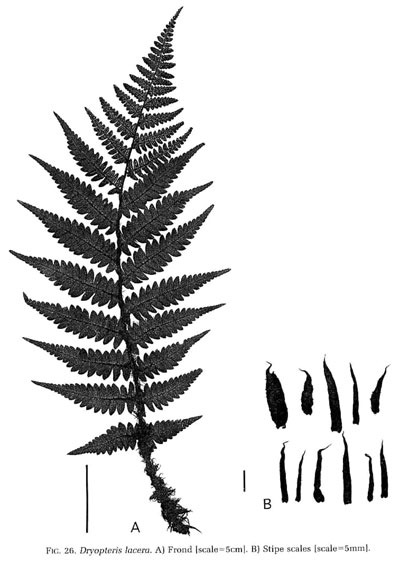| Dryopteris lacera | ||
|
Etymology
Latin: lacera, torn into fringelike segments
Description
Rhizome: erect, massive, bearing several fronds in a tuft, scaly.
Frond: 60 cm high by 20 cm wide, evergreen, somewhat dimorphic, fertile fronds with more and constricted pinnae at the , blade/stipe ratio: 3:1. Stipe: grooved, densely scaly throughout, brown to reddish brown, oblong-ovate to linear-lanceolate, larger ones to 2 cm long, membranous, vascular bundles: 3-7 in a C-shaped pattern. Blade: pinnate-pinnatifid to nearly 2-pinnate, oblong to ovate-oblong, herbaceous to somewhat leathery, linear to ovate scales below, absent above. Pinnae: 10 to 20 pair, lower sterile pinnae oblong-lanceolate, shortly stalked; fertile pinnae confined to upper portion, gradually smaller upwardly, covered entirely by sori, withering after maturation,; veins immersed on upper surfaces, distinct. Sori: round, entirely covering the fertile pinnae, indusium: reniform, sporangia: brownish. Culture
Habitat: floor of mountain forests, at edge of lowland forests.
Distribution: Japan, China, Korea.
Hardy to -25�C, USDA Zone 5.
Synonyms
Polypodium lacerum Thunb. Aspidium filix-mas var. lacerum Chr. Aspidium lacerum (Thunb.) Sw. Lastrea lacera (Thunb.) D.C. Eaton Nephrodium lacerum (Thunb.) Baker Polypodium lacerum Thunb. Polystichum lacerum Presl |
|
|
